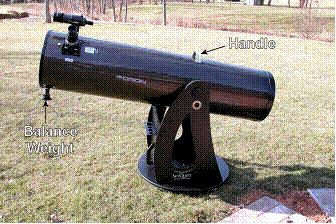Orion XT12 IntelliScope Review
Jack Kramer
In early February I received the 12" Orion IntelliScope I had ordered the previous week. I wanted just a bit more light gathering than afforded by my trusty old 10", and realized that in this size I'd have to go with a Dobsonian mount rather than the equatorial that I had always used. Since I prefer an optical finder rather than a unit-power finder (red-dot, Telrad, etc.) the scope had to be able to accommodate more weight at the eyepiece end. Orion's "Correct Tension" adjustment knob feature would also compensate for the weight of different eyepieces and other accessories. I ordered the scope without the computerized object locator because I'm a confirmed star-hopper - for me, the journey is as much fun as the destination. The solid tube of the XT12 eliminates the need for a light shroud, and while this makes it a handful to move, I don't need to disassemble a tube into smaller components for transportation purposes.

Step-by-step assembly took about two hours and was pretty intuitive, though it's a good idea to read through the manual beforehand. The first thing I discovered is that the scope is back-end heavy; that is, when aimed at a low altitude it wants to swing up, even with the Correct Tension knobs torqued down pretty tight. To correct this, I replaced the little knob opposite the focuser with a 1 lb. weight. This allows the scope to balance properly with a wide range of eyepieces while not inducing jerkiness in the altitude motion. Secondly, a solid-tube 12" scope is pretty heavy, but worse still is that it's awkward. To fix this, I added a handle atop the tube between the altitude bearings. This makes it much easier to move and set up. (I also discovered that it provides a good handhold when moving the tube while it's aimed upward near "Dobson's Hole".) Even at high magnification, the tube moves smoothly in both directions.
After a week of crummy skies (no surprise), I finally had a chance to test it under the stars. With a moon just past full phase, it wasn't a good time for testing on DSOs, but at least it was clear and Saturn was well positioned. I didn't use the optional cooling fan that I had purchased for the scope and that was a mistake - even after almost an hour outside, the star images were bloated and a defocused image showed massive swirling air currents. (As mirrors get larger, more time is required for acclimation ... a fact I knew but had yet to experience personally.) The Clear Sky Clock indicated that the seeing would not be good for our area, but the transparency seemed better than predicted. After two hours, the images improved but a defocused image showed there was still a lot of seething air that was probably of atmospheric origin. Despite this moving distortion, a preliminary star test showed a classic Airy disk, concentric diffraction rings both inside and outside of focus, and a uniformly circular shape, so the optics look decent. However, the secondary mirror seems to be offset a bit too much in the direction of the primary so that the focuser drawtube does not appear in the exact center of the secondary. This is easy to adjust, but since the secondary is large enough, there should be no vignetting as it now stands. At just under $1000, this IntelliScope is a bargain for what you get.





